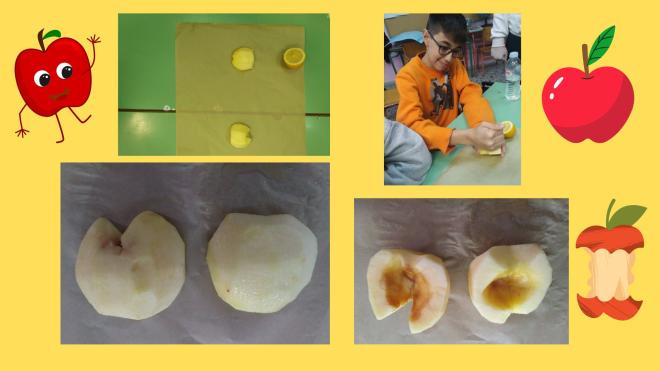“ In the apple- lab” Science experiments with apples
COLLABORATIVE WORK LINK
Science lab report worksheet:
ROCÍO GONZÁLEZ and Christian Bonet
COLEGIO ECOLE
Asturias -Spain
Will the apple sink or float?
Students are going to find out...
Sibel Bayraktar
Şehit Öğretmen Şekip Akın Primary School Class 1-I
Nilüfer Bursa Türkiye
Since my students could not read or write yet, we could not write an experiment report. We observed how the apples you peeled changed day by day. Based on the change of peeled apples, we decided that our skin is very important to us.
2.b Primary school Čazma, Croatia
Anita Mikulandra
Experiment: an apple with the skin swims because there is air in the skin, and an apple without the skin sinks deeper into the water.
2.b Primary school Čazma, Croatia
Oxidation experiment with apple
We observed what would happen to a peeled apple in the air, poured with water, lemon and cooking oil. The apple browned the fastest in the air, and lemon juice had the best effect.
Ivona Mijoč, Osnovna škola Blatine-Škrape, Split, Croatia
We did two experiments with apples. In first, students observed will apples sink or float. Contrary to students' prediction, apples didn't sink. We learned that it's because they are less dense than water. In the second experiment we observed how apple seeds "dance". When baking soda and vinegar interact, carbon dioxide gas is created which forms bubbles and it makes apple seeds rise and fall.
We are making the science experiment with apple and lemon. We take an apple half and place it in cut-side down into the bowl of lemon juice. We leave it in one hour. The other apple half without lemon juice is our control. We observe the color of both halves, then we place them white plate upon the plates. The "control" was brown but the "lemon" didn't change the color. Our result: lemon juice preserve apples. (Students from class 3b Szkoła Podstawowa nr 15 Wrocław Poland)
Istituto Comprensivo E. Falcetti - Apice - Italy
2nd Primary School of Thermi
Stella Kovatsi - Katerina Karya -Papadopoulou Sevasti
Oxidation of the apple
The 6th grade students worked on the apple oxidation experiment.They cut the apple and the lemon into two equal parts.Grate one half of the apple inside it lemon and put half of this piece of the apple in a bowl. In the other bowl they put the other half of the apple piece as it is without putting anything.Theyleft two bowls at room temperature for afew hours and then observed the two pieces of apples.The result in the appearance of the apple is what you will also notice in the part with the apple that did not use the lemon that the inside of the apple decomes darker.The air cannot penerate inside the apple decause of this and only the surface blackens.

















